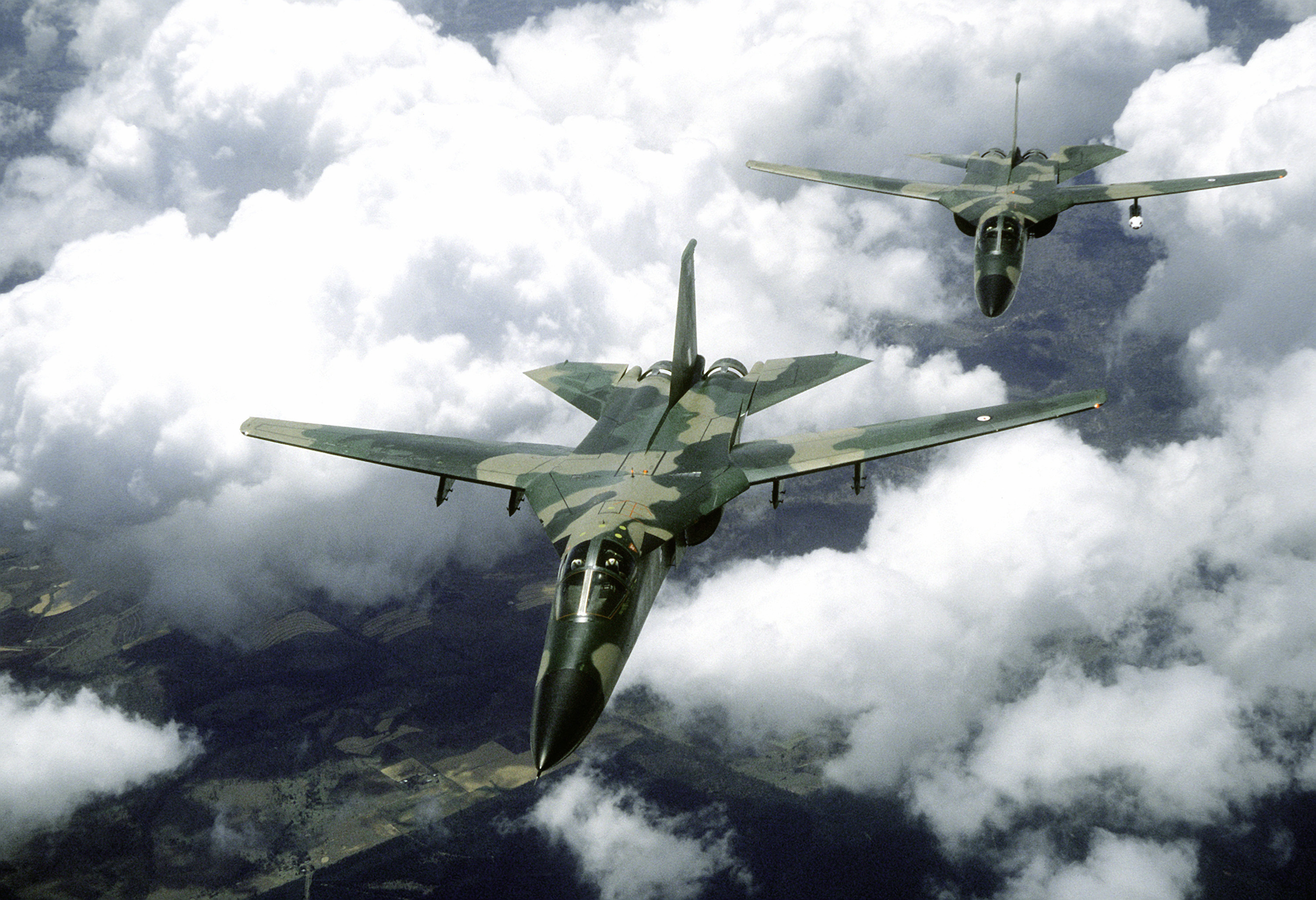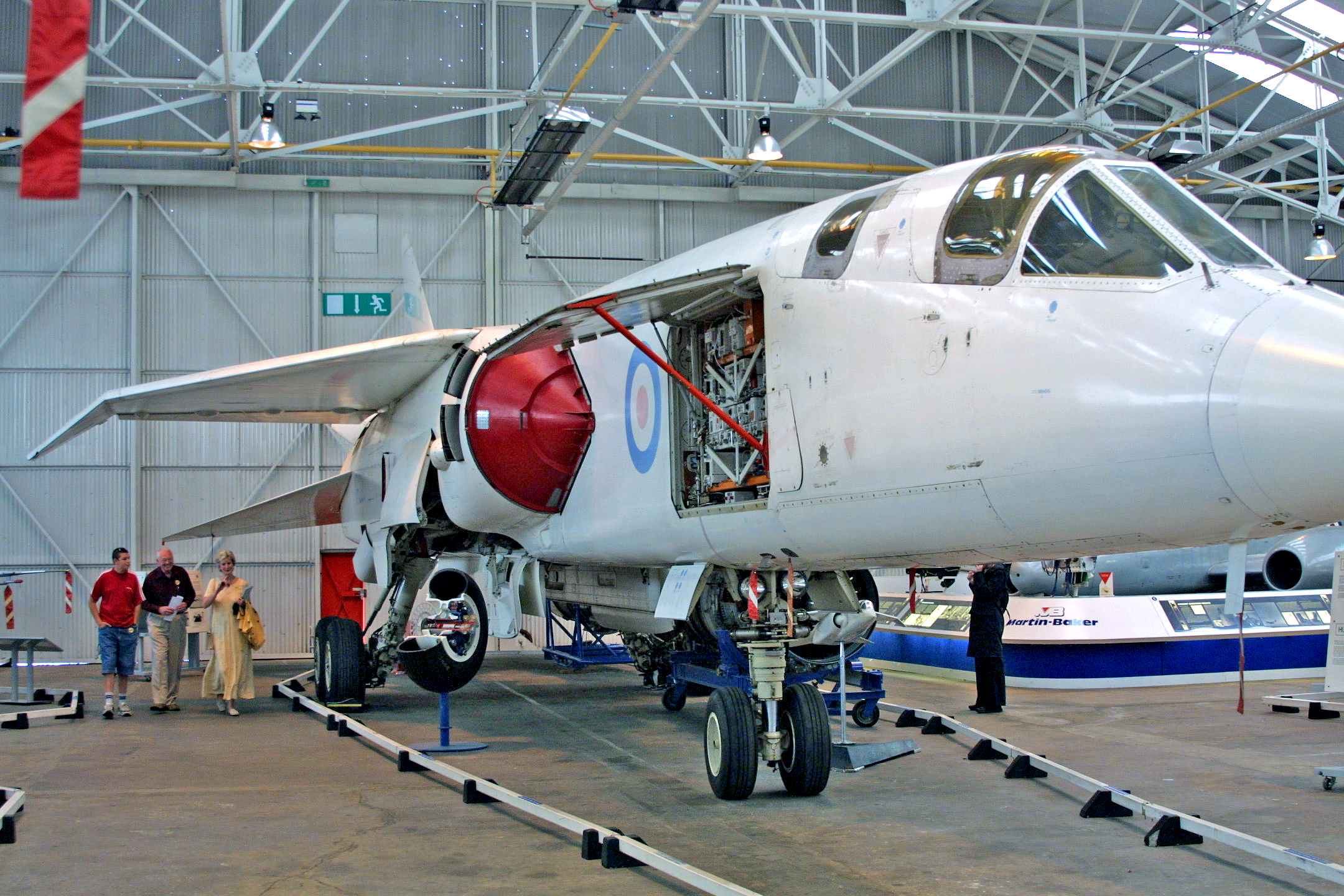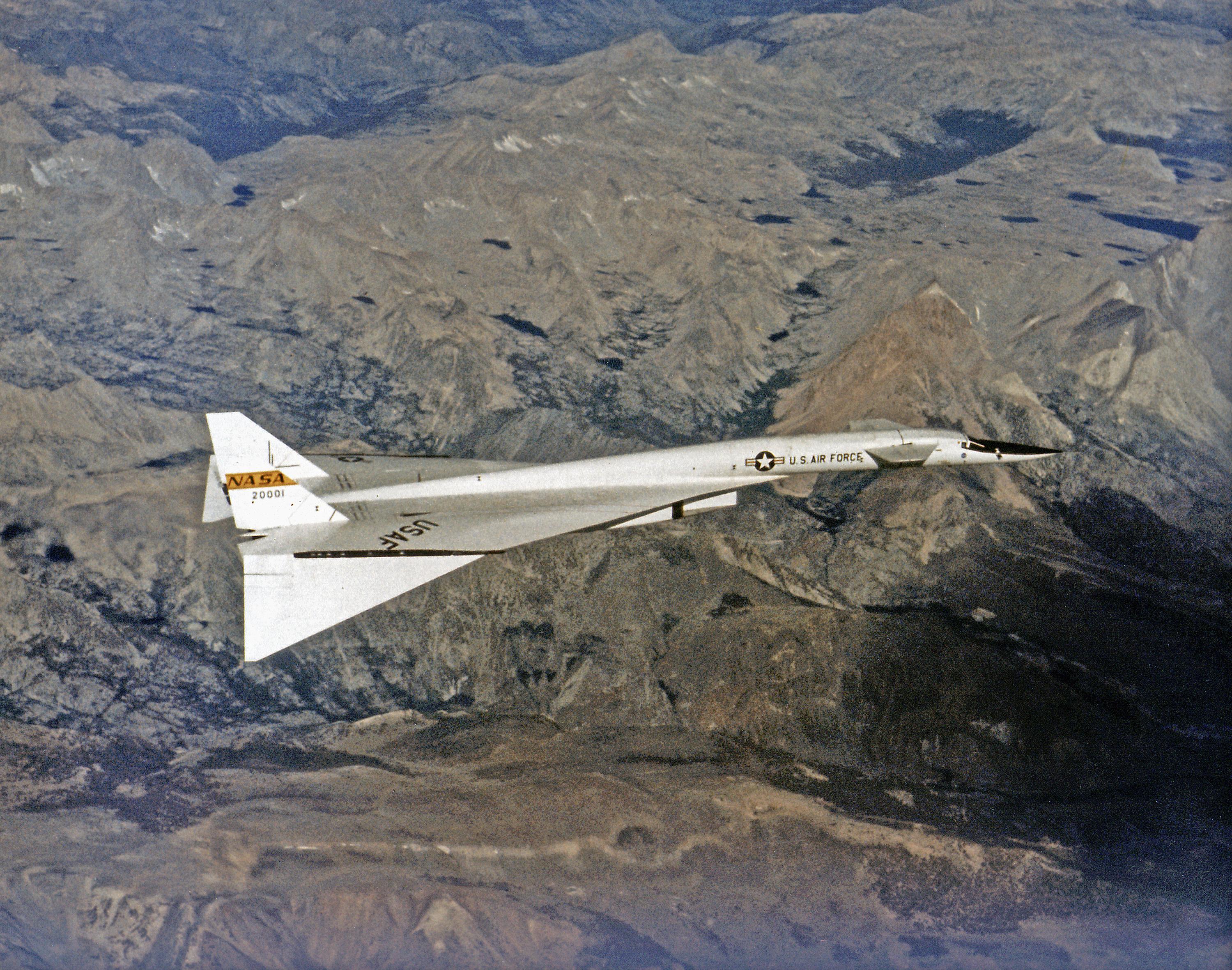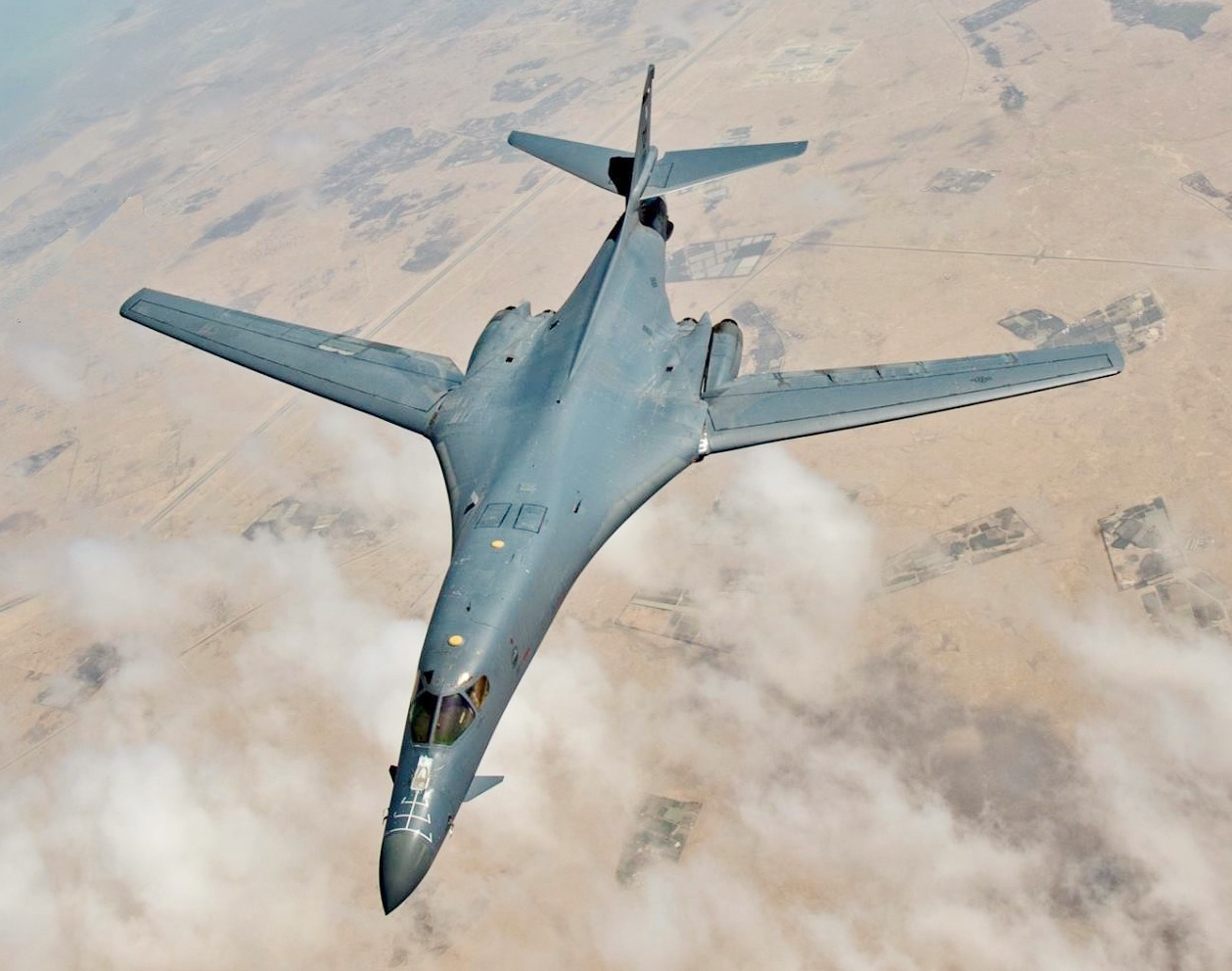|
F-111
The General Dynamics F-111 Aardvark is a retired supersonic, medium-range, multirole combat aircraft. Production variants of the F-111 had roles that included ground attack (e.g. interdiction), strategic bombing (including nuclear weapons capabilities), reconnaissance and electronic warfare. Developed in the 1960s by General Dynamics, the F-111 entered service in 1967 with the United States Air Force (USAF). The Royal Australian Air Force (RAAF) also ordered the type and began operating the F-111C variant in 1973. The F-111 pioneered several technologies for production aircraft, including variable-sweep wings, afterburning turbofan engines, and automated terrain-following radar for low-level, high-speed flight. Its design influenced later variable-sweep wing aircraft, and some of its advanced features have since become commonplace. The F-111 suffered a variety of problems during initial development. A fighter variant, the F-111B, was not accepted for production. The F ... [...More Info...] [...Related Items...] OR: [Wikipedia] [Google] [Baidu] |
General Dynamics F-111C
The General Dynamics F-111C (nicknamed "Pig") is a variant of the General Dynamics F-111 Aardvark, F-111 Aardvark medium-range interdictor and fighter bomber, tactical strike aircraft, developed by General Dynamics to meet Australian requirements. The design was based on the F-111A model but included longer wings and strengthened undercarriage. The Australian government ordered 24 F-111Cs to equip the Royal Australian Air Force (RAAF) in 1963, but the aircraft were not delivered until 1973 because of long-running technical problems. During 1979 and 1980 four of these aircraft were converted to the RF-111C reconnaissance variant. Four ex–United States Air Force (USAF) F-111As were purchased by Australia and converted to F-111C standard in 1982 to replace F-111Cs destroyed during accidents. Australia also operated 15 F-111Gs between 1993 and 2007, mainly for conversion training. The RAAF retired its remaining F-111Cs in December 2010. In Australian military and aviation circles, ... [...More Info...] [...Related Items...] OR: [Wikipedia] [Google] [Baidu] |
General Dynamics–Grumman F-111B
The General Dynamics–Grumman F-111B is a long-range carrier-based interceptor aircraft that was planned to be a follow-on to the F-4 Phantom II for the United States Navy (USN). The F-111B was developed in the 1960s by General Dynamics in conjunction with Grumman for the U.S. Navy as part of the joint Tactical Fighter Experimental (TFX) with the United States Air Force (USAF) to produce a common fighter for the services that could perform a variety of missions. It incorporated innovations such as variable-geometry wings, afterburning turbofan engines, and a long-range radar and missile weapons system. Designed in parallel with the F-111 "Aardvark", which was adopted by the Air Force as a strike aircraft, the F-111B suffered development issues and changing Navy requirements for an aircraft with maneuverability for dogfighting. The F-111B was not ordered into production and the F-111B prototypes were used for testing before being retired. The F-111B would be replaced by the sm ... [...More Info...] [...Related Items...] OR: [Wikipedia] [Google] [Baidu] |
General Dynamics–Grumman EF-111A Raven
The General Dynamics–Grumman EF-111A Raven is an electronic-warfare aircraft designed to replace the EB-66 Destroyer in the United States Air Force. Its crews and maintainers often called it the "Spark-Vark", a play on the F-111's "Aardvark" nickname. The USAF contracted with Grumman in 1974 to convert some existing General Dynamics F-111As into electronic warfare/electronic countermeasures (ECM) aircraft. The USAF had considered the Navy / Marine Corps Grumman EA-6B Prowler, but desired a penetrating aircraft with supersonic speed. The EF-111 entered service in 1983 and served until its retirement in 1998. Design and development In the late 1960s, the U.S. Air Force sought to replace its aging EB-66 and EB-57 electronic warfare aircraft. The Air Force studied the use of Navy EA-6B Prowlers during 1967–1968.Gunston 1983, p. 55. However, the Air Force desired a penetrating electronic jamming aircraft with supersonic speed, and, in 1972, decided to modify F-111As int ... [...More Info...] [...Related Items...] OR: [Wikipedia] [Google] [Baidu] |
General Dynamics F-111K
The General Dynamics F-111K was a planned variant of the General Dynamics F-111 Aardvark medium-range interdictor and fighter bomber, tactical strike aircraft by General Dynamics, to meet a requirement for such an aircraft for the Royal Air Force. The project was initiated in 1965 following the cancellation of the BAC TSR-2 strike aircraft. The aircraft was planned as a hybrid of several variants of the F-111 as a way of producing an aircraft for the specific needs of the United Kingdom. A RAF order for 50 aircraft, made in 1967, was cancelled a year later. Development Background In the early 1960s, the British Aircraft Corporation was in the process of developing a new strike aircraft for the Royal Air Force to replace the English Electric Canberra. This aircraft, designated as "BAC TSR-2, TSR-2" (Tactical Strike and Reconnaissance), had a large set of requirements listed by the government, and had led to TSR-2 becoming a hugely complex machine; it was intended that it be ab ... [...More Info...] [...Related Items...] OR: [Wikipedia] [Google] [Baidu] |
General Dynamics–Boeing AFTI/F-111A Aardvark
The General Dynamics–Boeing AFTI/F-111A Aardvark was a research aircraft modified from a General Dynamics F-111 Aardvark to test a Boeing-built supercritical mission adaptive wing (MAW). This MAW, in contrast to standard control surfaces, could smoothly change the shape of its airfoil in flight. Development The AFTI/F-111A was part of the Advanced Fighter Technology Integration (AFTI) Program by the United States Air Force Flight Dynamics Laboratory and NASA, which was an extension of the earlier transonic aircraft technology (TACT) program to install a supercritical wing onto an F-111. Unlike the TACT program, AFTI utilized a mission adaptive wing, which, instead of standard control surfaces, could smoothly change the shape of its airfoil in flight. The concept was inspired by birds, which change the shape of their wings to adapt to new flight conditions. By late 1981, Boeing had built a full-scale wing section and had received the variable-sweep actuator boxes fr ... [...More Info...] [...Related Items...] OR: [Wikipedia] [Google] [Baidu] |
Variable-sweep Wing
A variable-sweep wing, colloquially known as a "swing wing", is an airplane wing, or set of wings, that may be swept back and then returned to its original straight position during flight. It allows the aircraft's shape to be modified in flight, and is therefore an example of a variable-geometry aircraft. A straight wing is most efficient for low-speed flight, but for an aircraft designed for transonic or supersonic flight it is essential that the wing be swept. Most aircraft that travel at those speeds usually have wings (either swept wing or delta wing) with a fixed sweep angle. These are simple and efficient wing designs for high speed flight, but there are performance tradeoffs. One is that the stalling speed is increased, necessitating long runways (unless complex high-lift wing devices are built in). Another is that the aircraft's fuel consumption during subsonic cruise is higher than that of an unswept wing. These tradeoffs are particularly acute for naval carrier-b ... [...More Info...] [...Related Items...] OR: [Wikipedia] [Google] [Baidu] |
General Dynamics
General Dynamics Corporation (GD) is an American publicly traded, aerospace and defense corporation headquartered in Reston, Virginia. As of 2020, it was the fifth-largest defense contractor in the world by arms sales, and 5th largest in the United States by total sales. The company is a Fortune 100 company, and was ranked No. 94 in 2022. Formed in 1954 with the merger of submarine manufacturer Electric Boat and aircraft manufacturer Canadair, the corporation today consists of ten subsidiary companies with operations in 45 countries. The company's products include Gulfstream business jets, Virginia- and Columbia-class nuclear-powered submarines, Arleigh Burke-class guided-missile destroyers, M1 Abrams tanks and Stryker armored fighting vehicles. In 2021, General Dynamics had worldwide sales of $38.85 billion and a workforce of approximately 103,000 full-time employees. The current chairman and chief executive officer (CEO) is Phebe Novakovic. History Electric Boat Gen ... [...More Info...] [...Related Items...] OR: [Wikipedia] [Google] [Baidu] |
Terrain-following Radar
Terrain-following radar (TFR) is a military aerospace technology that allows a very-low-flying aircraft to automatically maintain a relatively constant altitude above ground level and therefore make detection by enemy radar more difficult. It is sometimes referred to as ''ground hugging'' or ''terrain hugging'' flight. The term ''nap-of-the-earth'' flight may also apply but is more commonly used in relation to low-flying military helicopters, which typically do not use terrain-following radar. TFR systems work by scanning a radar beam vertically in front of the aircraft and comparing the range and angle of the radar reflections to a pre-computed ideal manoeuvring curve. By comparing the distance between the terrain and the ideal curve, the system calculates a manoeuvre that will make the aircraft clear the terrain by a pre-selected distance, often on the order of . Using TFR allows an aircraft to automatically follow terrain at very low levels and high speeds. Terrain-following r ... [...More Info...] [...Related Items...] OR: [Wikipedia] [Google] [Baidu] |
Rockwell B-1 Lancer
The Rockwell B-1 Lancer is a supersonic variable-sweep wing, heavy bomber used by the United States Air Force. It is commonly called the "Bone" (from "B-One"). It is one of three strategic bombers serving in the U.S. Air Force fleet along with the B-2 Spirit and the B-52 Stratofortress . The B-1 was first envisioned in the 1960s as a platform that would combine the Mach 2 speed of the B-58 Hustler with the range and payload of the B-52, and was meant to ultimately replace both bombers. After a long series of studies, Rockwell International (now part of Boeing) won the design contest for what emerged as the B-1A. This version had a top speed of Mach 2.2 at high altitude and the ability to fly for long distances at Mach 0.85 at very low altitudes. The combination of the high cost of the aircraft, the introduction of the AGM-86 cruise missile that flew the same basic speed and distance, and early work on the B-2 stealth bomber reduced the need for the B-1. The program was cance ... [...More Info...] [...Related Items...] OR: [Wikipedia] [Google] [Baidu] |
Strategic Bomber
A strategic bomber is a medium- to long-range Penetrator (aircraft), penetration bomber aircraft designed to drop large amounts of air-to-ground weaponry onto a distant target for the purposes of debilitating the enemy's capacity to wage war. Unlike tactical bombing, tactical bombers, Penetrator (aircraft), penetrators, fighter-bombers, and attack aircraft, which are used in air interdiction operations to attack enemy combatants and military equipment, strategic bombers are designed to fly into enemy territory to destroy strategic targets (e.g., infrastructure, logistics, Military base, military installations, factories, etc.). In addition to strategic bombing, strategic bombers can be used for tactical bombing, tactical missions. There are currently only three countries that operate strategic bombers: the United States, Russia and China. The modern strategic bomber role appeared after Strategic bombing during World War II, strategic bombing was widely employed, and Atomic bombing ... [...More Info...] [...Related Items...] OR: [Wikipedia] [Google] [Baidu] |
Electronic-warfare Aircraft
An electronic-warfare aircraft is a military aircraft equipped for electronic warfare (EW), that is, degrading the effectiveness of enemy radar and radio systems by using radar jamming and deception methods. In 1943, British Avro Lancaster aircraft were equipped with chaff in order to blind enemy air defence radars. They were supplemented by specially-equipped aircraft flown by No. 100 Group RAF, which operated modified Halifaxes, Liberators and Fortresses carrying various jammers such as ''Carpet'', ''Airborne Cigar'', ''Mandrel'', ''Jostle'', and ''Piperack''. List of electronic-warfare aircraft Examples of modern aircraft designed or modified for EW include: * Antonov An-12BK-PPS ( Soviet Union) * Antonov An-26REP ( Soviet Union) * Boeing EA-18G Growler ( United States) * Denel TP1 Oryx EW ( South Africa) * Chengdu J-10D ( China) * Douglas C-47TP EW ( South Africa) * Douglas EA-3 Skywarrior ( United States) * Douglas EB-66 Destroyer ( United States) * Douglas EF-1 ... [...More Info...] [...Related Items...] OR: [Wikipedia] [Google] [Baidu] |
McDonnell Douglas F-15E Strike Eagle
The McDonnell Douglas (now Boeing) F-15E Strike Eagle is an American all-weather multirole strike fighter derived from the McDonnell Douglas F-15 Eagle. The F-15E was designed in the 1980s for long-range, high-speed interdiction without relying on escort or electronic-warfare aircraft. United States Air Force (USAF) F-15E Strike Eagles can be generally distinguished from other US Eagle variants by darker aircraft camouflage, conformal fuel tanks (CFTs) mounted along the engine intake ramps (although CFTs can also be mounted on earlier F-15 variants) and a tandem-seat cockpit. The Strike Eagle has been deployed for military operations in Iraq, Afghanistan, Syria, and Libya, among others. During these operations, the strike fighter has carried out deep strikes against high-value targets and combat air patrols, and provided close air support for coalition troops. It has also been exported to several countries. Development Origins The McDonnell Douglas F-15 Eagle was int ... [...More Info...] [...Related Items...] OR: [Wikipedia] [Google] [Baidu] |











